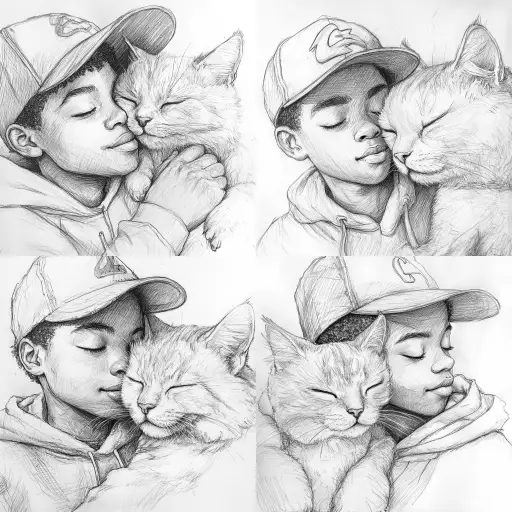Explore the Best AI Image Gallery

AI-Powered Visions: Reshaping the Design Landscape with Generative Images
The creative world is witnessing a seismic shift, fueled by the emergence of artificial intelligence (AI) and its ability to generate stunningly realistic images. Generative AI models, trained on massive datasets of visual information, are empowering designers, artists, and businesses to explore new frontiers in creativity and innovation. From conceptualizing designs to crafting marketing materials, AI-powered image generation is poised to revolutionize the design industry.
Unlocking Creative Potential: Applications Across Design Disciplines
The versatility of generative AI extends across a wide spectrum of design disciplines:
- Graphic Design: Generate logos, branding assets, marketing collateral, and social media graphics with unprecedented speed and efficiency.
- Web and UI/UX Design: Create captivating visuals for websites, apps, and user interfaces, tailoring designs to specific target audiences.
- Illustration and Concept Art: Visualize ideas and bring fictional worlds to life with original artwork, pushing the boundaries of artistic expression.
- Fashion Design: Generate novel garment designs, experiment with textile patterns, and explore new aesthetics in clothing.
The Power of Personalization: Tailoring Designs to Individual Needs
One of the most exciting aspects of generative AI is its ability to personalize designs. By leveraging user input, preferences, and data, AI models can create unique visuals that resonate with specific individuals:
- E-commerce: Generate product mockups tailored to individual customer preferences, enhancing the online shopping experience.
- Personalized Marketing: Create targeted marketing campaigns with images that speak directly to specific customer segments.
- Customizable Products: Allow users to design their own products, from apparel to home decor, using AI-powered tools.
Navigating Ethical Considerations: Ensuring Responsible Use
While the potential of generative AI is immense, its crucial to address ethical considerations associated with its use in design:
- Copyright and Intellectual Property: Establish clear guidelines for ownership and attribution of AI-generated content.
- Bias and Representation: Ensure that training data used for AI models is diverse and representative to avoid perpetuating harmful biases in generated images.
- Transparency and Explainability: Strive for transparency in the AI design process, allowing users to understand how images are generated and make informed decisions.
The Future of Design: A Collaborative Landscape
The future of design lies in a collaborative landscape where humans and AI work together. Generative AI will augment human creativity, enabling designers to:
- Focus on Conceptualization and Strategy: Leverage AI to handle repetitive tasks, freeing up time for designers to focus on high-level creative thinking.
- Explore Unconventional Ideas: Use AI as a tool to generate novel concepts and push the boundaries of design innovation.
- Create Immersive Experiences: Combine generative AI with other technologies like VR and AR to develop engaging and interactive design experiences.
Embracing the Transformation
As AI-powered image generation continues to evolve, its essential for designers, educators, and industry leaders to embrace this transformative technology. By fostering collaboration, addressing ethical considerations, and championing responsible use, we can unlock the full creative potential of generative AI and shape a future where design is more innovative, personalized, and accessible than ever before.





](https://images.ai-img.art/thumbnails/150/157712d76865d557120f9baf988de3d0525225295a2789c89bf2c4a5a96a03d1.webp)
![**Representation: A dog acting as a private tutor to a child. The dog holds a ruler in its paw and stands at the blackboard to explain a dog diagram to the child. Graphic style: Line drawing, cartoon style, influenced by Franco-Belgian comics, thick black lines, simplified design, vector, black and white only, in the style of Keith Haring or the French comic strip "Alinéa". [IMPORTANT]: A single continuous line extending from one side of the image to the other, minimalist, strong outlines, line drawing, without lifting the hand, ultra-simplified, no shading, entirely white image, drawing created in the center of a sheet of paper. --ar 16:5** - <@627984126871470085> (fast)](https://images.ai-img.art/thumbnails/150/7a854648a81e51241dcca8d24dd6e3bfcf07ad1df51baf401c9b729f4cf411fa.webp)

![**Representation: A dog acting as a private tutor to a child. The dog holds a ruler in its paw and stands at the blackboard to explain a dog diagram to the child. Graphic style: Line drawing, cartoon style, influenced by Franco-Belgian comics, thick black lines, simplified design, vector, black and white only, in the style of Keith Haring or the French comic strip "Alinéa". [IMPORTANT]: A single continuous line extending from one side of the image to the other, minimalist, strong outlines, line drawing, without lifting the hand, ultra-simplified, no shading, entirely white image, drawing created in the center of a sheet of paper. --ar 16:5** - Variations (Strong) by <@627984126871470085> (fast)](https://images.ai-img.art/thumbnails/150/f4e034998ccd869d8a061fd12017514fcd92210eb33d4222dc9b54716223f4dd.webp)





![**Representation: A teenager smiling while thinking about a friendly dog, a comic-style thought bubble with a friendly dog inside. Graphic style: Line drawing, cartoon style, influenced by Franco-Belgian comics, thick black lines, simplified design, vector, black and white only, in the style of Keith Haring or the French comic strip "Alinéa". [IMPORTANT]: A single continuous line extending from one side of the image to the other, minimalist, strong outlines, line drawing, without lifting the hand, ultra-simplified, no shading, entirely white image, drawing created in the center of a sheet of paper. --ar 16:5** - <@627984126871470085> (fast)](https://images.ai-img.art/thumbnails/150/6fc850f638e3dee0c4b121acecad2c8419e02bdeac7f871d625f1003c1c3abe1.webp)



](https://images.ai-img.art/thumbnails/150/9d51c5e673b4f2068b7b01abc35425a06f173b76303adf9ad29ca14302c25b18.webp)










](https://images.ai-img.art/thumbnails/150/51c93500396faff4e7fa8b42bc68033067b16b2230e3496e95c482a581ff0fe9.webp)














